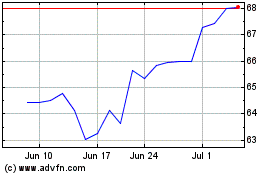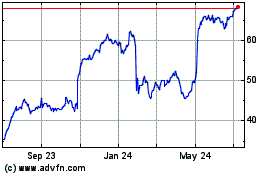Career Advisory Board 2016 Survey Reveals U.S. Workers Still Value Traditional Employment
November 21 2016 - 11:48AM
Business Wire
Report suggests attention-grabbing perks are
not all that desirable
The Career Advisory Board, established by DeVry University,
today announced the results of its survey on today’s most desirable
jobs. The results include the most ideal job characteristics, the
most appealing type of work style and the most prized values when
it comes to working.
Even as organizations try to keep up with the evolving workplace
by offering customized work arrangements and elaborate perks, in
the post-recession world many professionals prefer a return to the
basics. Surprisingly, 91 percent of millennials surveyed reported
they would like to work at a single full-time job. Eighty-one
percent overall said they would prefer a single position that’s
full-time. Less than 1 percent of respondents preferred special
company perks like onsite food, wellness perks and daycare to the
more crucial benefits such as medical/dental plans, paid time off
and retirement benefits, which rated the most important offerings
after competitive salary.
“The survey results show us that businesses today need to be
good employers, offering stable employment with competitive base
pay and traditional medical and retirement benefits,” said
Alexandra Levit, business and workplace consultant and Career
Advisory Board member. “The average American worker isn’t
necessarily looking for all the bells and whistles.”
The survey is meant to offer actionable advice to job seekers
and hiring managers. With a healthier job market than in recent
years, job seekers today have more employment options and greater
control over their careers.
Key Findings in the 2016 Most Desirable Jobs
Survey
Preferred Work Arrangements
- Of the 81 percent of respondents who
prefer a single full-time position, an overwhelming number didn’t
mind going into an office, but would like some location flexibility
(59 percent).
- Twenty-two percent of respondents said
they prefer to go into an office every day, while 18 percent said
they’d like working from home all the time. Millennials were more
likely to want to work in an office every day than their older
colleagues (27 percent).
Hierarchy over Holacracy
- A majority (56 percent) of respondents
said they prefer a job with “authority to make decisions that
impact the entire organization,” and 36 percent said they still
prefer to work for a single manager within a hierarchical
structure.
- Eighteen percent said they enjoy
working for a variety of managers in a matrixed structure, and only
11 percent of respondents said they prefer the holacratic style, in
which there are no official managers and everyone’s input is valued
equally. Millennials, interestingly, were only a little more likely
to say they prefer matrixed or holacratic reporting
structures.
Stability, a Primary Need
- Respondents slightly preferred jobs
that were exciting (57 percent) to predictable (43 percent), and
were equally enthused by fun (50 percent) and challenging (50
percent) work, but they overwhelmingly preferred jobs that were
stable (84 percent) to risky (16 percent). Even 78 percent of
millennials, who are oftentimes associated with job-hopping, said
they prefer a stable job situation.
Compensation and Perks
- Our respondents echoed the notion that
competitive compensation is most crucial, followed by role and work
schedule. With respect to what would keep our respondents at a
company, competitive compensation was again the top priority, with
flexibility and challenging work in the second and third
spots.
- Contrary to popular belief, even
millennials surveyed said they wouldn’t choose a flexible job
situation over lucrative pay.
The long-standing power of compensation should not be forgotten
by employers seeking to attract and retain the best talent.
“According to the survey, compensation is still a top consideration
for job applicants,” said Madeleine Slutsky, chair of the Career
Advisory Board and vice president of career and student services at
DeVry University. “Likewise, in order to stay competitive in the
marketplace, companies should continually evaluate how they reward
and compensate employees in order to retain top talent.”
Our 500 respondents represented a diverse sample of American
workers. Fifty-one percent were female and 49 percent were male,
with 17 percent between ages 22-35, 29 percent 36-49, and 54
percent 53-64. Eighty-two percent were employed full-time, nine
percent were employed part-time, and eight percent were
self-employed. Eight percent of respondents were skilled laborers,
16 percent were administrative level professionals, seven percent
were entry-level professionals, 52 percent were mid-level
professionals, and 17 percent were senior or executive-level
professionals.
For more information, please visit www.careeradvisoryboard.org.
About the Career Advisory Board
Established in 2010 by DeVry University, the Career Advisory
Board is comprised of leading representatives from business and
academia who deliver valuable insights on today’s most important
career trends and provide actionable advice for job seekers. The
Career Advisory Board generates original research and commentary,
and creates tools, insights and resources to prepare job seekers
for success. Its members include executives from DeVry University,
Google, Apple, HP, IBM, and LinkedIn, as well as nationally
recognized career experts. For more information, visit CareerAdvisoryBoard.org.
Survey Methodology
The Career Advisory Board’s Most Desirable Jobs research was
designed to discover the most preferred employment situations among
American workers in order to provide hiring managers with
intelligence that can help them recruit and retain talent in what
is increasingly a job seekers’ market.
The survey of 504 workers was conducted online within the United
States by DeVry University on behalf of the Career Advisory Board
in July 2016.
View source
version on businesswire.com: http://www.businesswire.com/news/home/20161121005893/en/
Anne UngerDeVry Universityaunger@devry.edu630-353-7009
Adtalem Global Education (NYSE:ATGE)
Historical Stock Chart
From Mar 2024 to Apr 2024

Adtalem Global Education (NYSE:ATGE)
Historical Stock Chart
From Apr 2023 to Apr 2024
